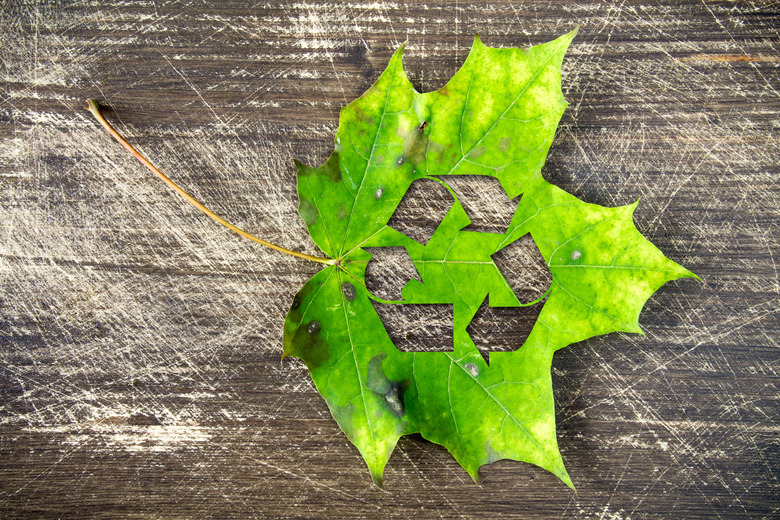A New Form Of Recycling: Creating Materials That Self-Destruct
Plastic trash, mobile phones, and other nondegradable materials account for millions of tons of waste thrown away each day. But researchers at the Technical University in Munich, Stanford University and research and development departments around the world have found ways to create materials that self-destruct, following nature's recycling plan.
Artificial Materials are Made to Last
Artificial Materials are Made to Last
Fossil fuels and petroleum have become mainstays of products that include plastics, electronics, fabrics, and more, and typically don't biodegrade like materials made from natural, Earth-based resources such as:
- trees
- plants
Even though petroleum was created by the biodegradation of dinosaurs, when manufacturers started using petroleum to make plastics and other products, they ended up creating indestructible goods.
Self-Destructive Materials
Self-Destructive Materials
Because most man-made materials are typically stable and don't exchange molecules with their environment, they are basically indestructible. In nature, organic matter is not in balance and will begin to degrade without input from sources that help to rebuild cellular structures.
Life Cycle of Self-Destructive Materials
Life Cycle of Self-Destructive Materials
Taking cues from nature, researchers at the Technical University in Munich have found ways to make materials that self-destruct. When these products lack energy sources, such as adenosine triphosphate – a coenzyme the human body uses to convert glucose from fats, carbohydrates and proteins into energy – these new self-destructive materials begin to break down, much in the same way that nature biodegrades organic matter. Without the energy source, just like in nature, these man-made materials begin to die.
Self-Destructive Material Uses
Self-Destructive Material Uses
Scientists at Stanford University have developed faux wood made from biodegradable plastics. The biodegradable plastics can replace indestructible plastics, and the wood can be used to make building materials, biodegradable electronics and even plastic bottles that break down. Virtually any product made with nondestructible components can be made from these new materials.
Medical Applications
Medical Applications
By making materials that self-destruct or break down into their original building blocks, engineers and researchers postulate that they can make frameworks for drug delivery and transplant anchors. Researchers at UCLA have also developed a hydrogel that creates a scaffold to allow wounds to heal and tissue to regenerate as the structure biodegrades. The hydrogel promotes rapid regeneration allowing wounds and skin grafts, among other medical uses, to heal quicker.
Man-Made Materials and Environmental Health
Man-Made Materials and Environmental Health
The online newspaper, The Guardian, stated in a January 2017 article that, "annual consumption of plastic bottles is set to top half a trillion by 2021, far outstripping recycling efforts and jeopardizing oceans, coastlines and other environments." Claiming that world's plastic addiction is more dangerous than climate change, plastics have a negative affect both on the Earth and its oceans' environmental health. The article also stated that a million plastic bottles are purchased every minute, which is building toward this environmental crisis. Adding to the problem, is that only half of all the plastic purchased is ever recycled.
What it all Means
What it all Means
Materials that self-destruct can begin to alleviate the burgeoning environmental crisis that threatens to overtake our oceans and landfills. By developing products that self-degrade, dangerous plastics and chemicals will no longer affect the Earth's biosphere. By not adding to the already existing pollution problem, scientists may be able to develop less costly methods to collect and recycle existing petroleum-based plastics into other uses. In the long run, the means to eliminate plastic and other pollution problems begins with recycling at home, work and school.
References
- R&D: Researchers Develop Supramolecular Materials that Disintegrate at a Predetermined Time
- Live Science: Why Doesn't Plastic Biodegrade?
- Stanford University: Stanford Researchers Develop Biodegradable Substitutes for Wood, Plastic Bottles and Other Common Materials
- University of California at Los Angeles: UCLA Researchers Develop New Material to Accelerate Healing
- Live Science: Self-Destructing Materials Could Create Vanishing Ink
- The Royal Society of Chemists: Chemistry World — Self-destructing material mimics nature
- New Scientist: Old Toys Will Self-Destruct Thanks to Vanishing Plastic
- The Guardian: A Million Bottles A Minute: World's Plastic Binge 'a Dangerous as Climate Change'
Cite This Article
MLA
Brenner, Laurie. "A New Form Of Recycling: Creating Materials That Self-Destruct" sciencing.com, https://www.sciencing.com/a-new-form-of-recycling-creating-materials-that-self-destruct-13559038/. 25 September 2017.
APA
Brenner, Laurie. (2017, September 25). A New Form Of Recycling: Creating Materials That Self-Destruct. sciencing.com. Retrieved from https://www.sciencing.com/a-new-form-of-recycling-creating-materials-that-self-destruct-13559038/
Chicago
Brenner, Laurie. A New Form Of Recycling: Creating Materials That Self-Destruct last modified March 24, 2022. https://www.sciencing.com/a-new-form-of-recycling-creating-materials-that-self-destruct-13559038/
